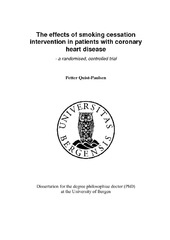| dc.description.abstract | Background: Smoking cessation is the most important action to reduce mortality after a coronary event. Largely, it has previously been unknown whether a smoking cessation program applicable in an ordinary clinical setting has any impact on smoking cessation rates in patients with coronary heart disease, and whether such a program is cost effective. Objectives: To determine whether a nurse managed smoking cessation intervention changes abstinence rates in patients admitted for coronary heart disease, to assess the predictors of smoking cessation, to evaluate whether smoking cessation has any impact on Quality of Life, to estimate the cost effectiveness of the smoking cessation program, and to appraise the feasibility of a fear arousal message. Design: Randomised controlled trial of usual care compared with individual smoking cessation intervention. Setting: The cardiac ward in Sørlandet Sykehus, Kristiansand, Norway. Participants: 240 smokers under 76 years of age admitted for myocardial infarction, unstable angina or cardiac bypass surgery. 118 were randomly assigned to the intervention and 122 to usual care (control group). 218 patients (91%) completed the study and were assessable at 12 months follow up. Methods: The intervention was based on an especially made 17 page booklet and focused on fear arousal and relapse prevention. Individual smoking cessation was delivered by cardiac nurses without special training. The intervention was initiated in hospital, and the participants were telephoned regularly for at least five months. Abstinence rates were determined by self report and biochemical verification. Survival data from previously published investigations, with life time extrapolation of the survival curves by survival function modelling, were used to be able to estimate the cost effectiveness of the program. Baseline characteristics were prospectively recorded, and health-related Quality of Life was measured at baseline and at 12 months follow up. The patient satisfaction was assessed at 12 months follow up. Results: 12 months after randomisation 57.0% and 37.3% were abstinent in the intervention and control groups, respectively (95% confidence interval for the difference 6.4 to 33.0). The number needed to treat to get one additional quitter was 5.1 (95% CI 3.0 to 15.6). Assuming all drop outs returned to smoking at 12 months, the cessation rates were 50.0% and 37.0% in the intervention and control group, respectively (95% CI for the difference 0.4 to 25.7). In a life time perspective, the incremental cost per year of life gained by the cessation program was Euro 280 and Euro 110 in the low and high risk group, respectively (2000 prices). These costs compare favourably to other treatment modalities in patients with coronary heart disease, being approximately 1/25 the cost of both statins in the low risk group and angiotensin converting enzyme inhibitors in the high risk group. In a sensitivity analysis, the costs remained low in a wide range of assumptions. The participants were in general satisfied with the cessation program, indicating that implementing a fear arousal message is a feasible method. In multivariate logistic regression analysis, a high level of nicotine addiction was a strong negative predictor of smoking cessation in both the intervention and the control group. The quitters and sustained smokers had similar improvements in all Quality of Life domains from baseline to 12 months follow up. Further, after adjustment for differences in baseline characteristics, the Quality of Life at baseline was not significantly associated with smoking cessation at 12 months follow up. Conclusions: A smoking cessation program delivered by cardiac nurses without special training, significantly reduced smoking rates 12 months after hospitalisation for coronary heart disease. The program was very cost effective compared to other treatment modalities in patients with coronary heart disease in terms of cost per life year gained. Among those with a high level of nicotine addiction, more effective cessation programs are needed. | en_US |





